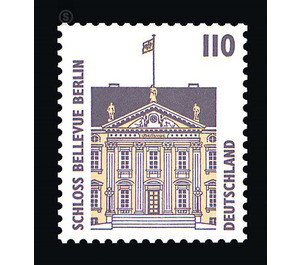Postage stamps: Places of interest - Germany / Federal Republic of Germany 1997 - 110 Pfennig
Theme: Architecture
| Country | Germany / Federal Republic of Germany |
| Issue Date | 1997 |
| Face Value | 110.00 |
| Color | brown white |
| Perforation | K 14 |
| Printing Type | indirect 2-color letterpress |
| Stamp Type | Postage stamp |
| Item Type | Stamp |
| Chronological Issue Number | 1808 |
| Chronological Chapter | GER-BRD |
| SID | 180768 |
| In 48 Wishlists | |
The Bellevue Palace, in the northern part of the Tiergarten in Berlin, was built in 1785/86 according to the plans of Philipp Daniel Boumann, including older buildings from 1764 for Prince August Ferdinand of Prussia, the youngest brother of Frederick II (1740) -1786), built. The elongated, built after the model of French Baroque palaces and with echoes of the beginning Classicism, construction consists of a central tract and two side wings, which include a court of honor to the front. While the three-storey side wings are completely unadorned, the two-storey main building is provided with a hinted, centered by an Attica Mittelrisalit. After Prince August Ferdinand of Prussia, the castle passed to his son August, before it acquired King Frederick William IV (1840-1861) in 1843. In the second half of the 19th century, the castle had no permanent residents. The castle was given a new function in the First World War, when in 1916 important conferences of the Supreme Command, the Government and the Allied Powers took place. During the Second World War, the castle was badly damaged. After already 1948 the ladies and the Spreeflügel had been repaired for the accommodation of bomb-damaged, began in 1954 the conversion of the lock to the official residence of the Federal President. In doing so, numerous changes made in 1938 were eliminated, the exterior restored, and the interior was fundamentally modernized. Only the ballroom was restored in its old form. On June 18, 1959, the Bellevue Castle was handed over to its present purpose. (Text: Representation of the State of Berlin at the Federal Government and for Europe, Bonn)


